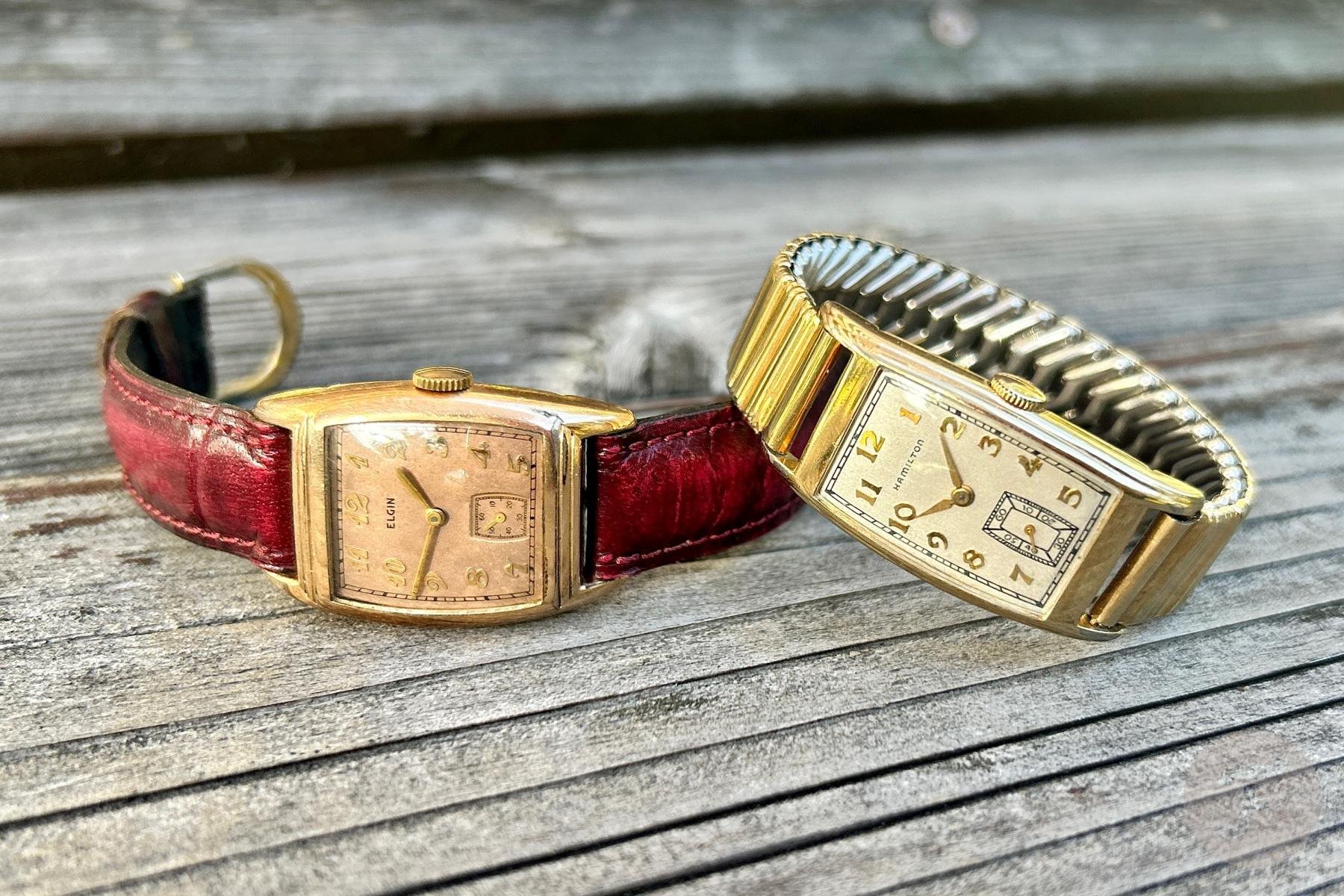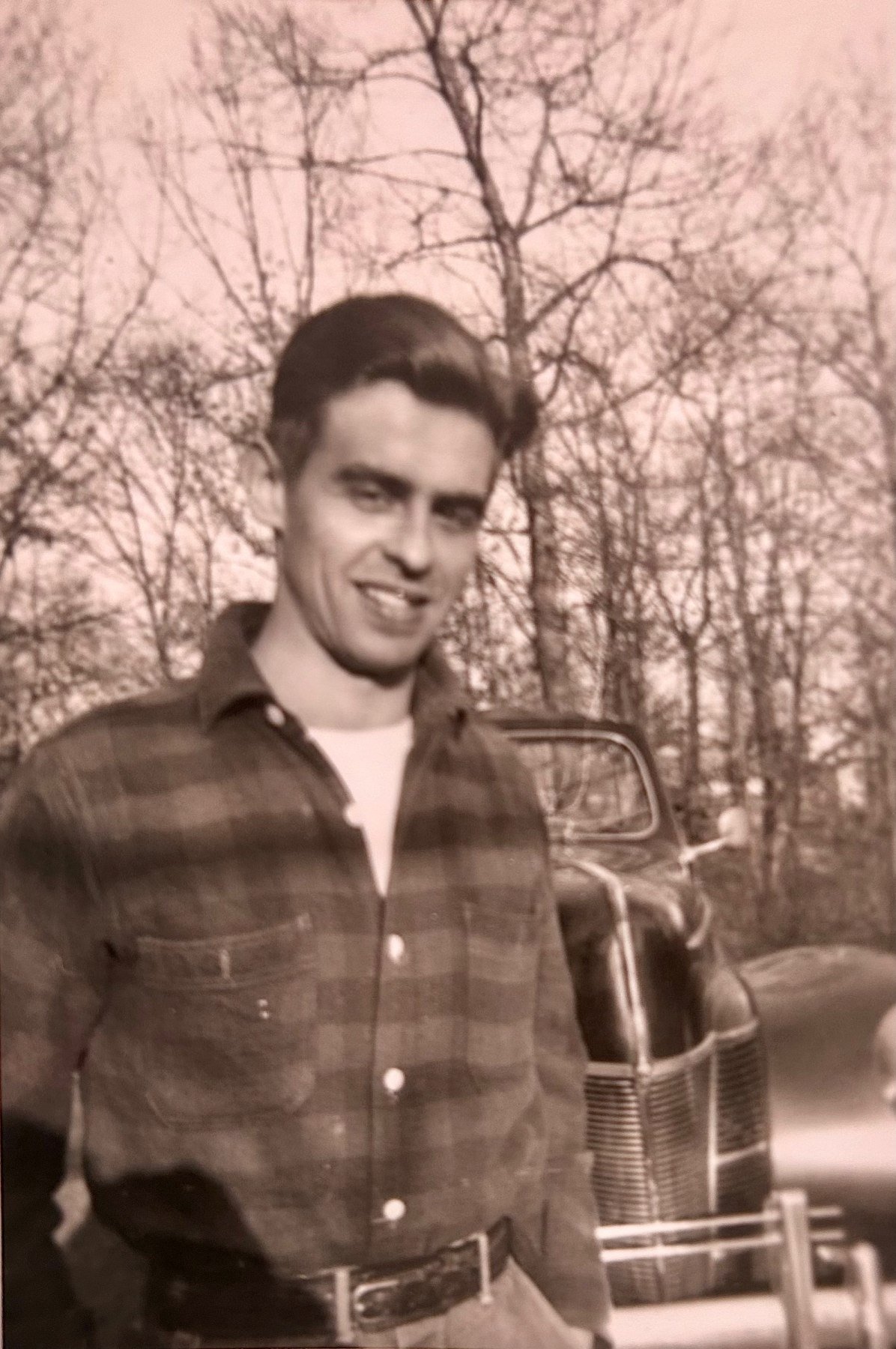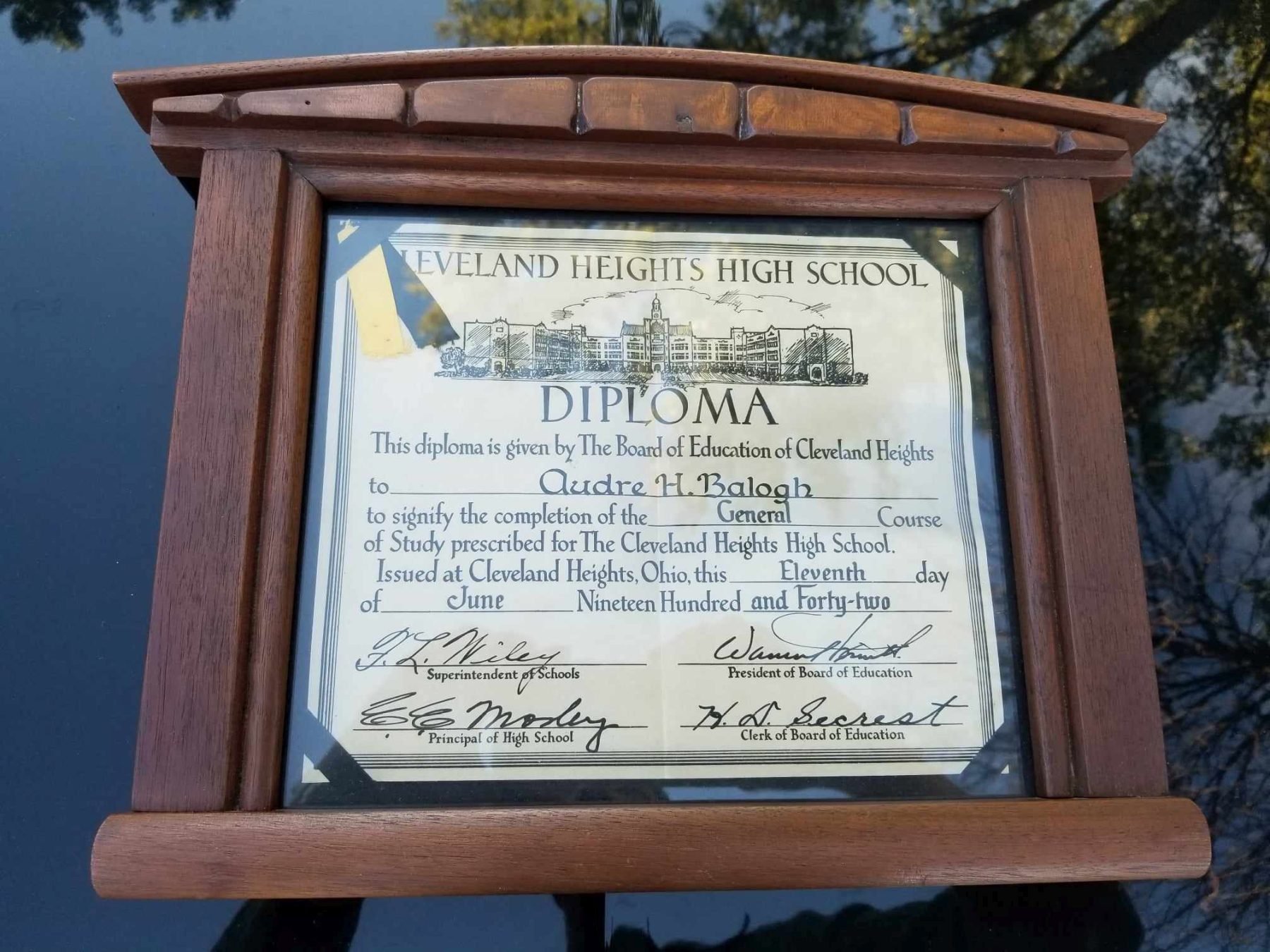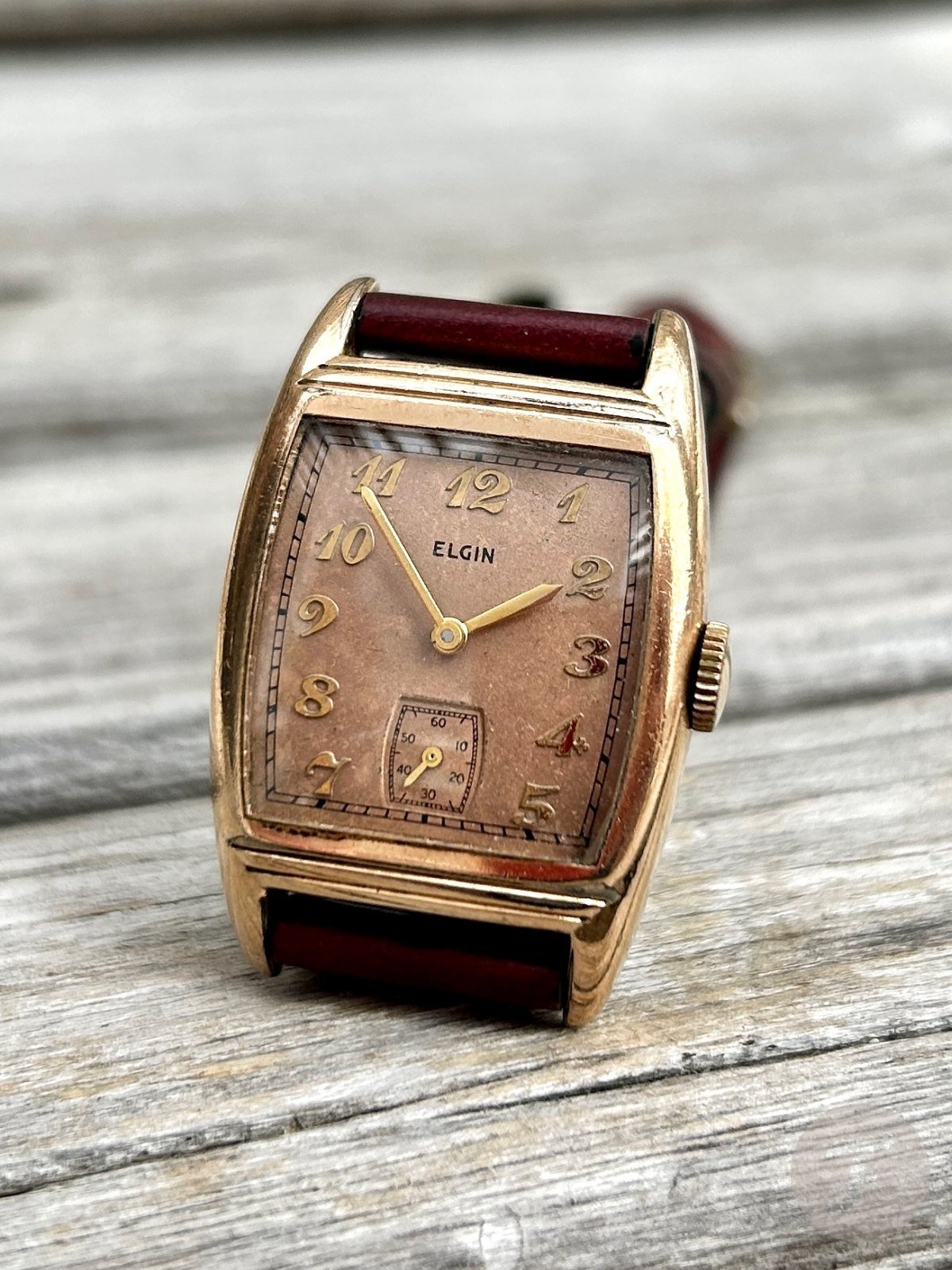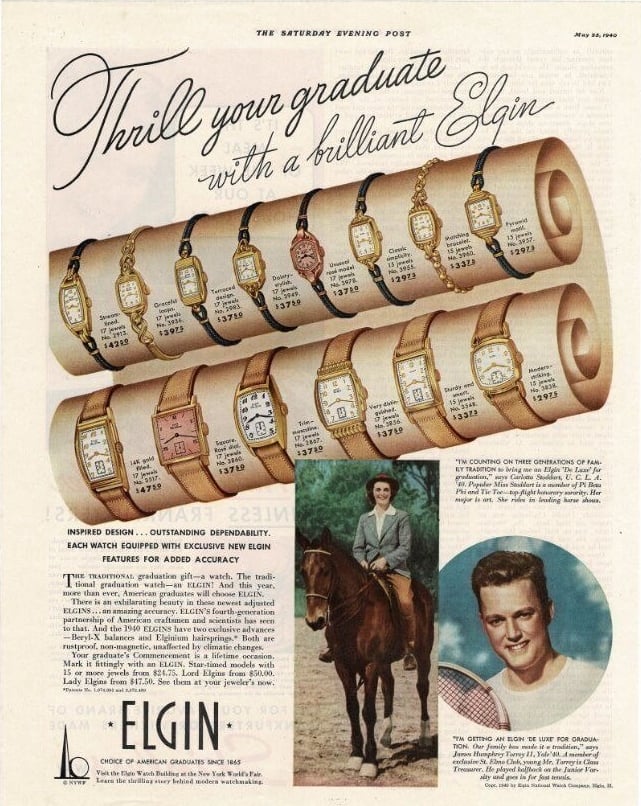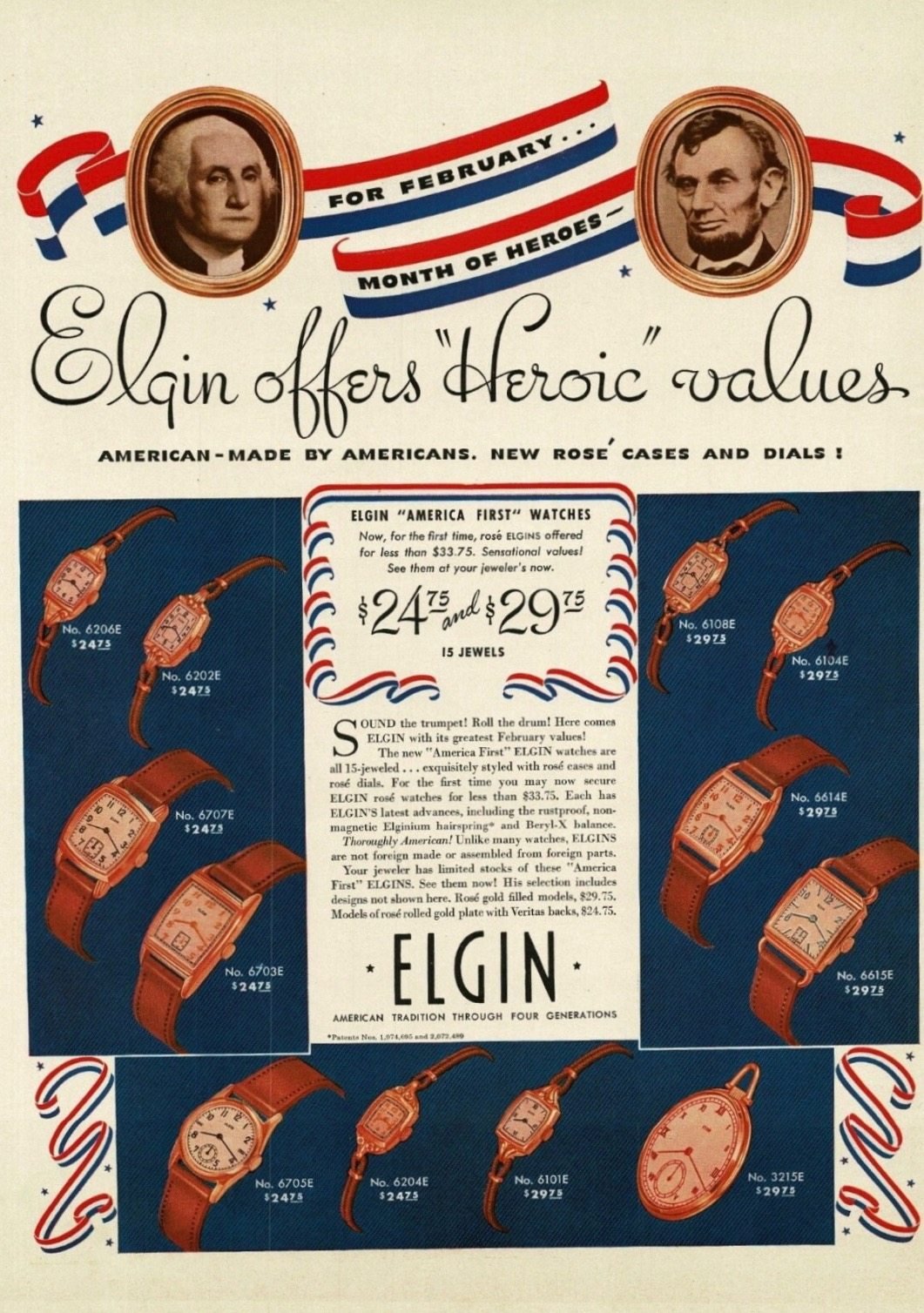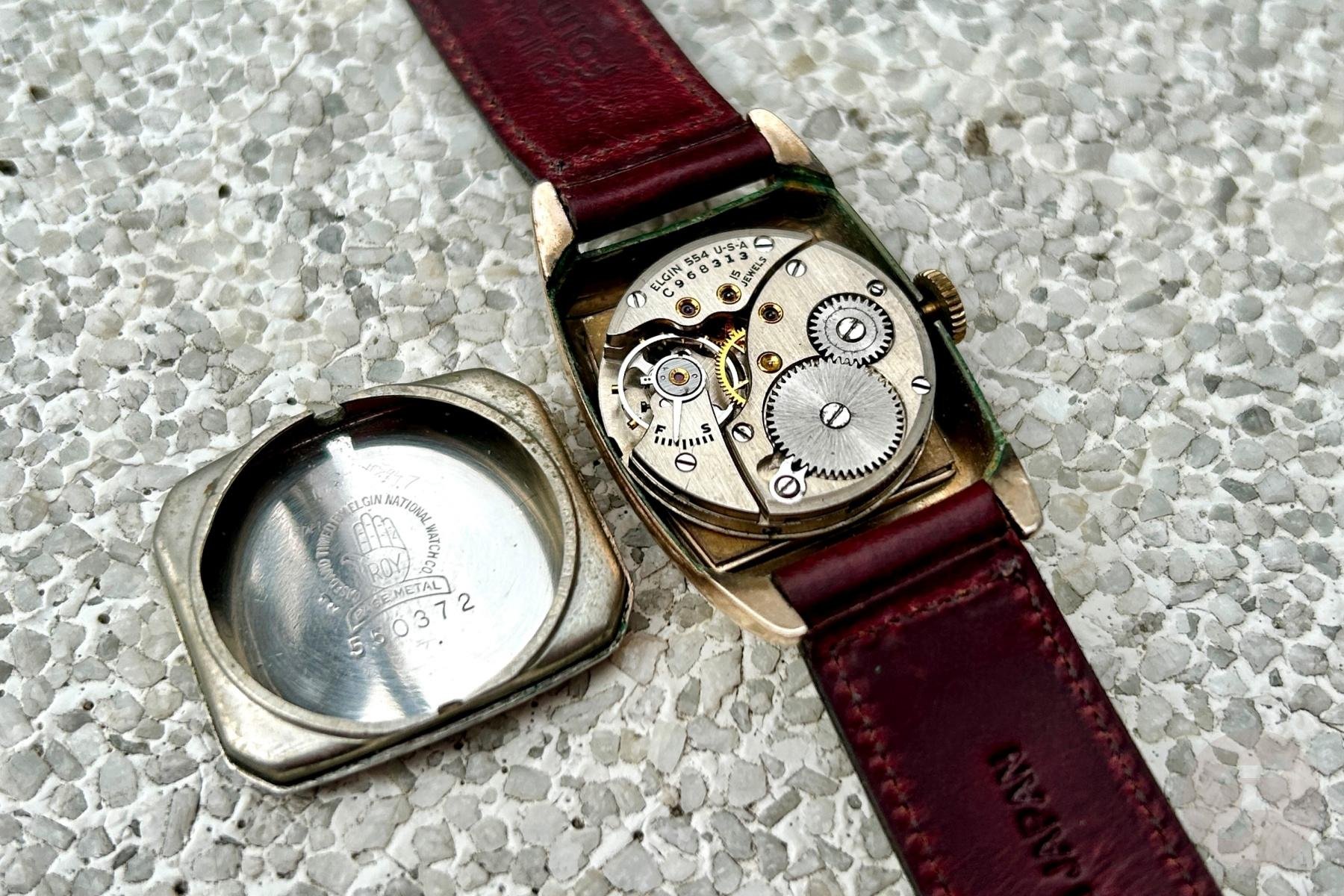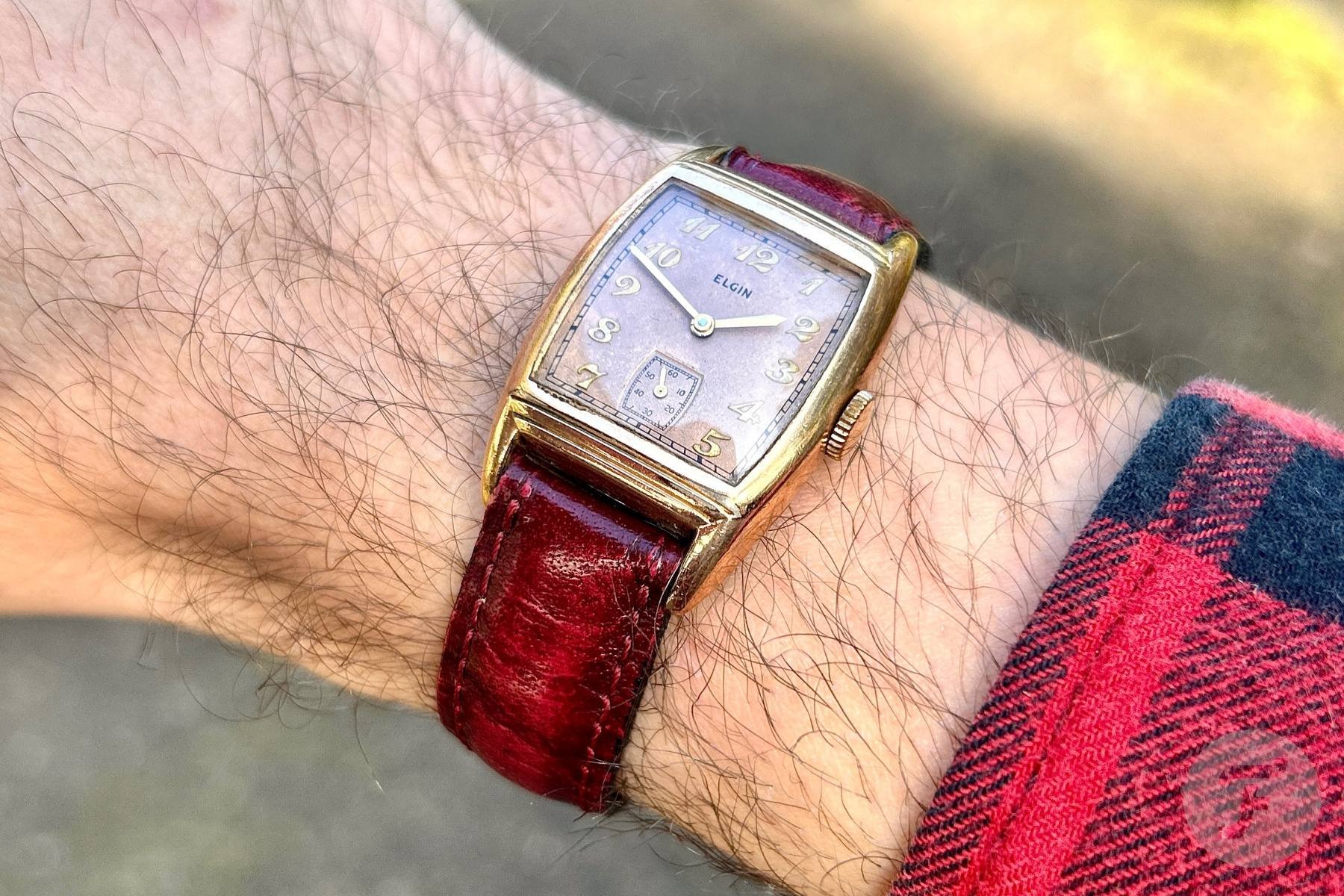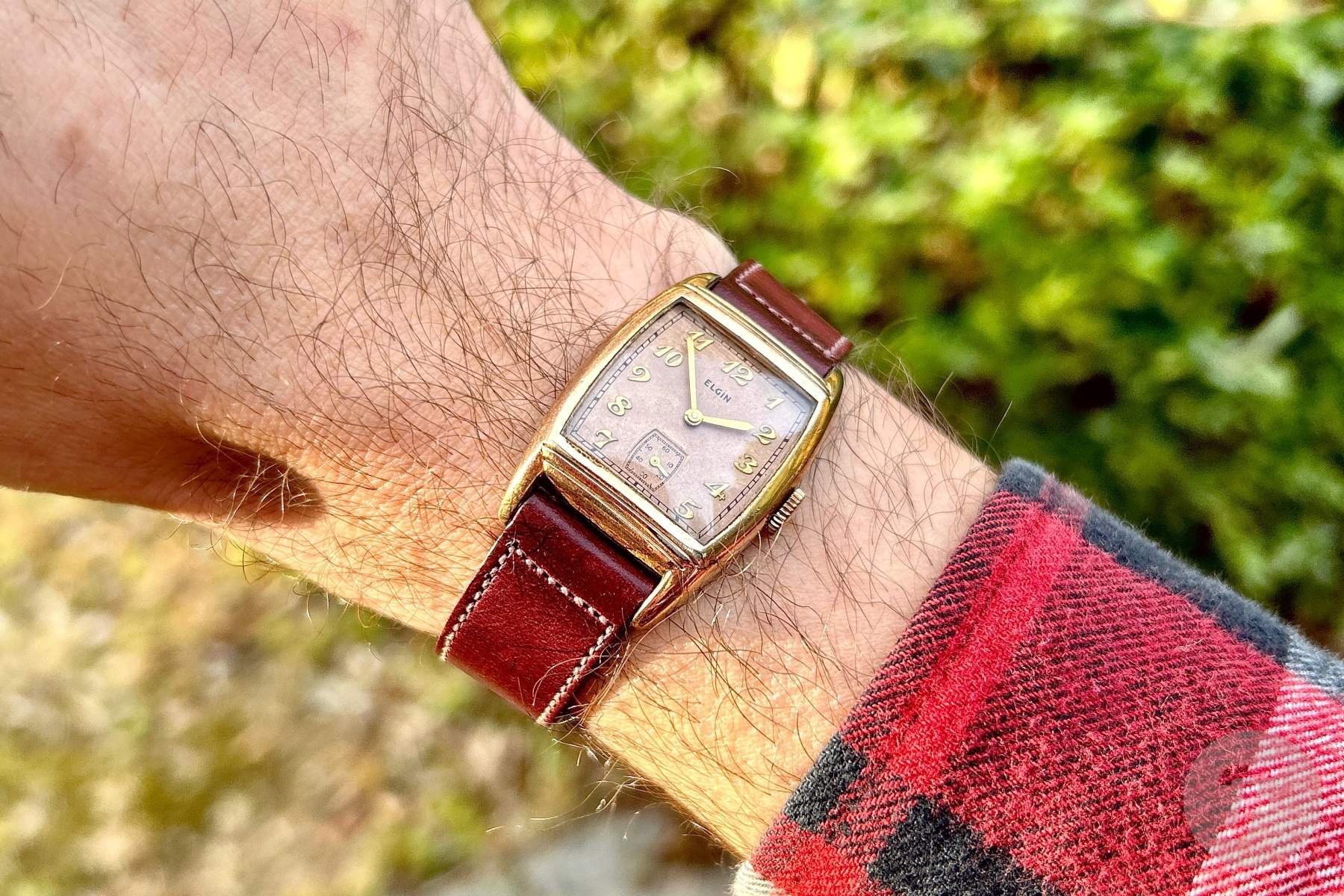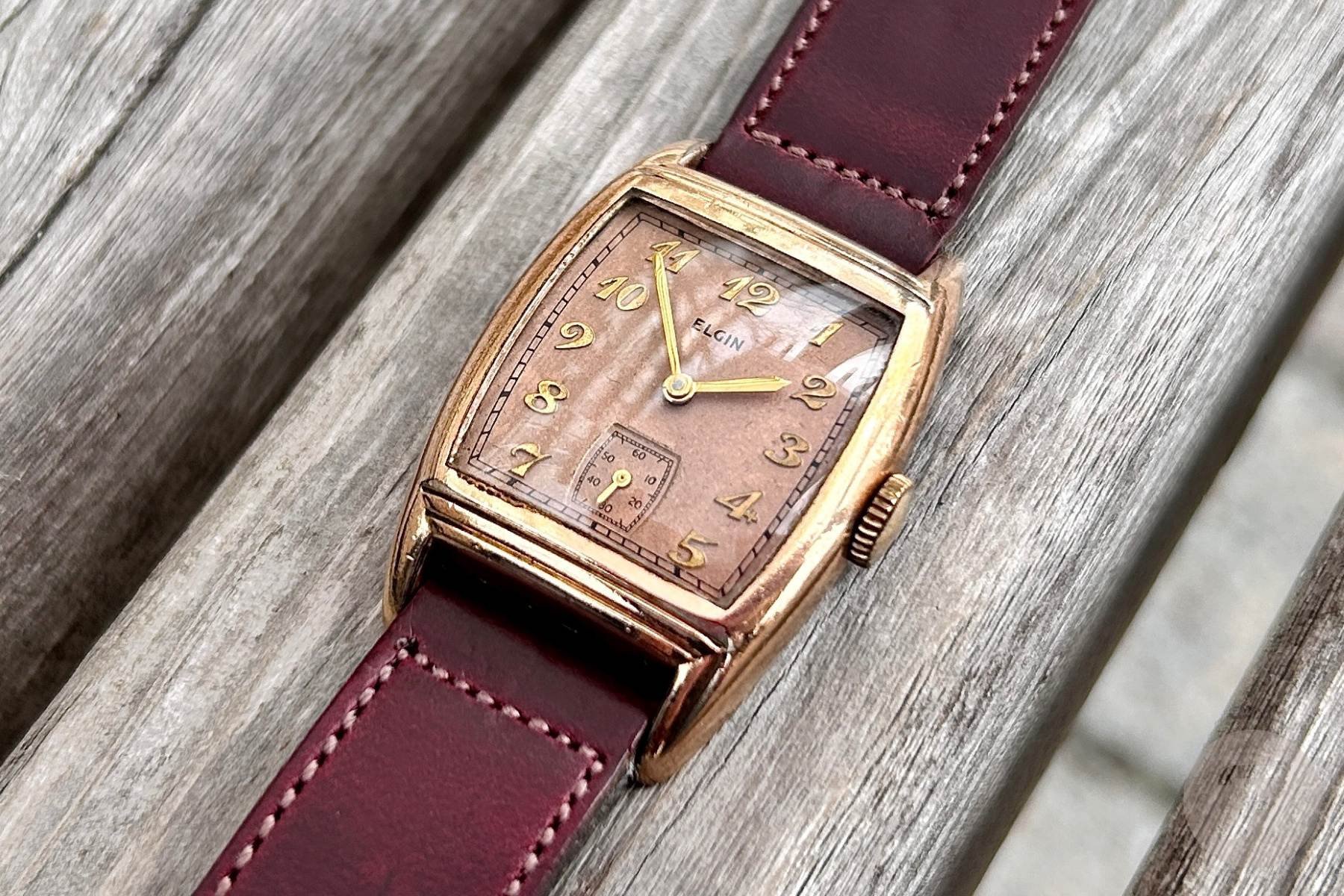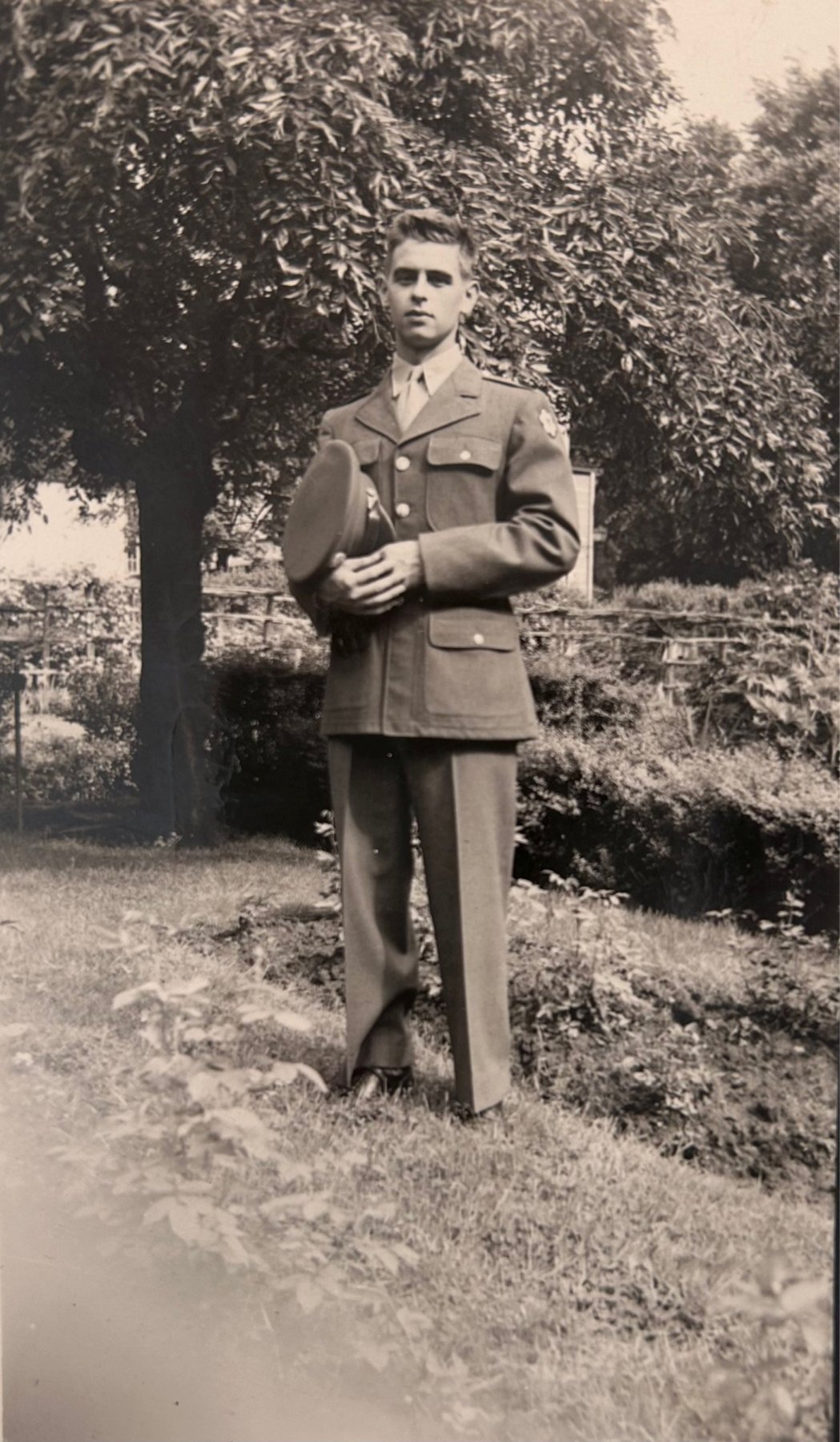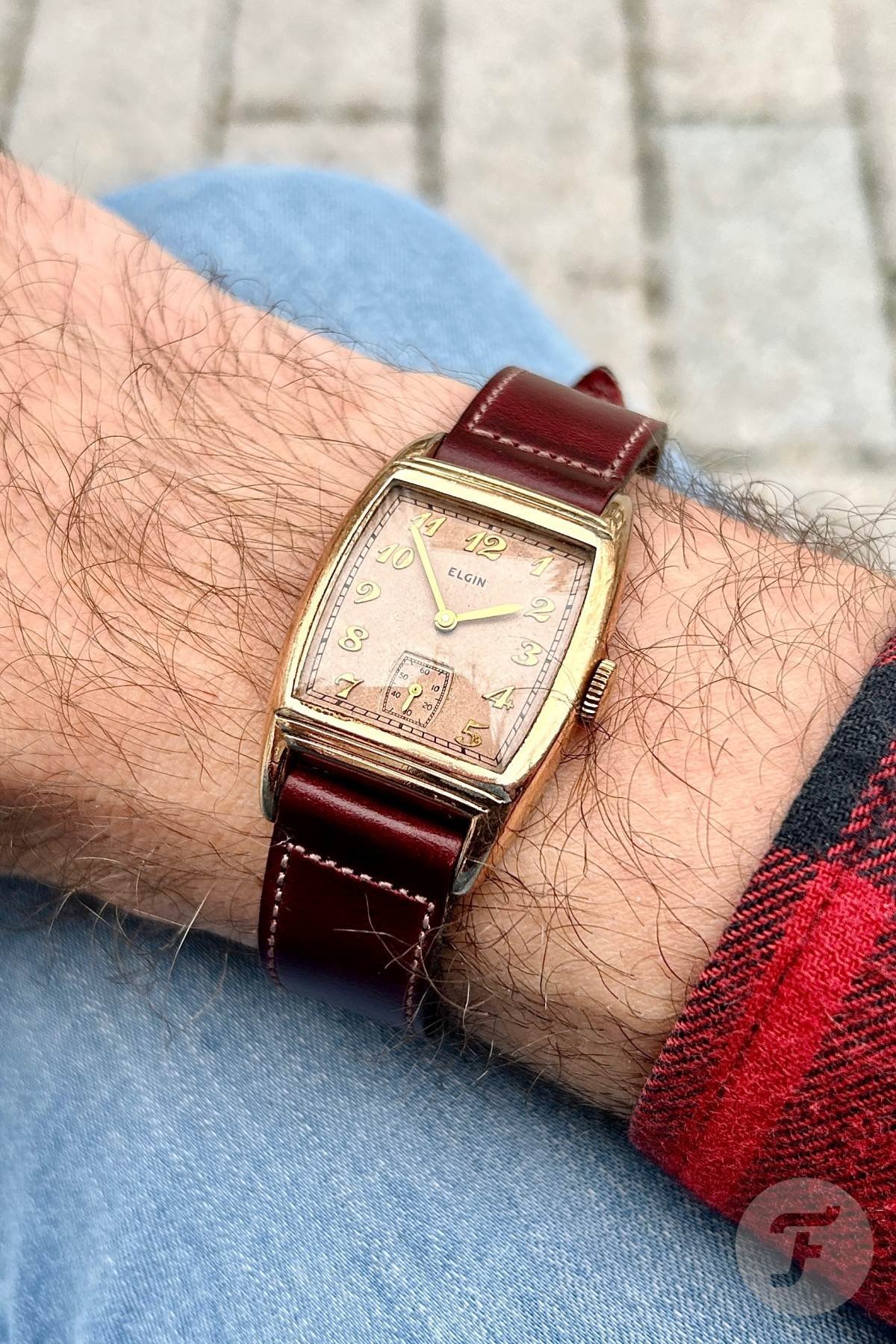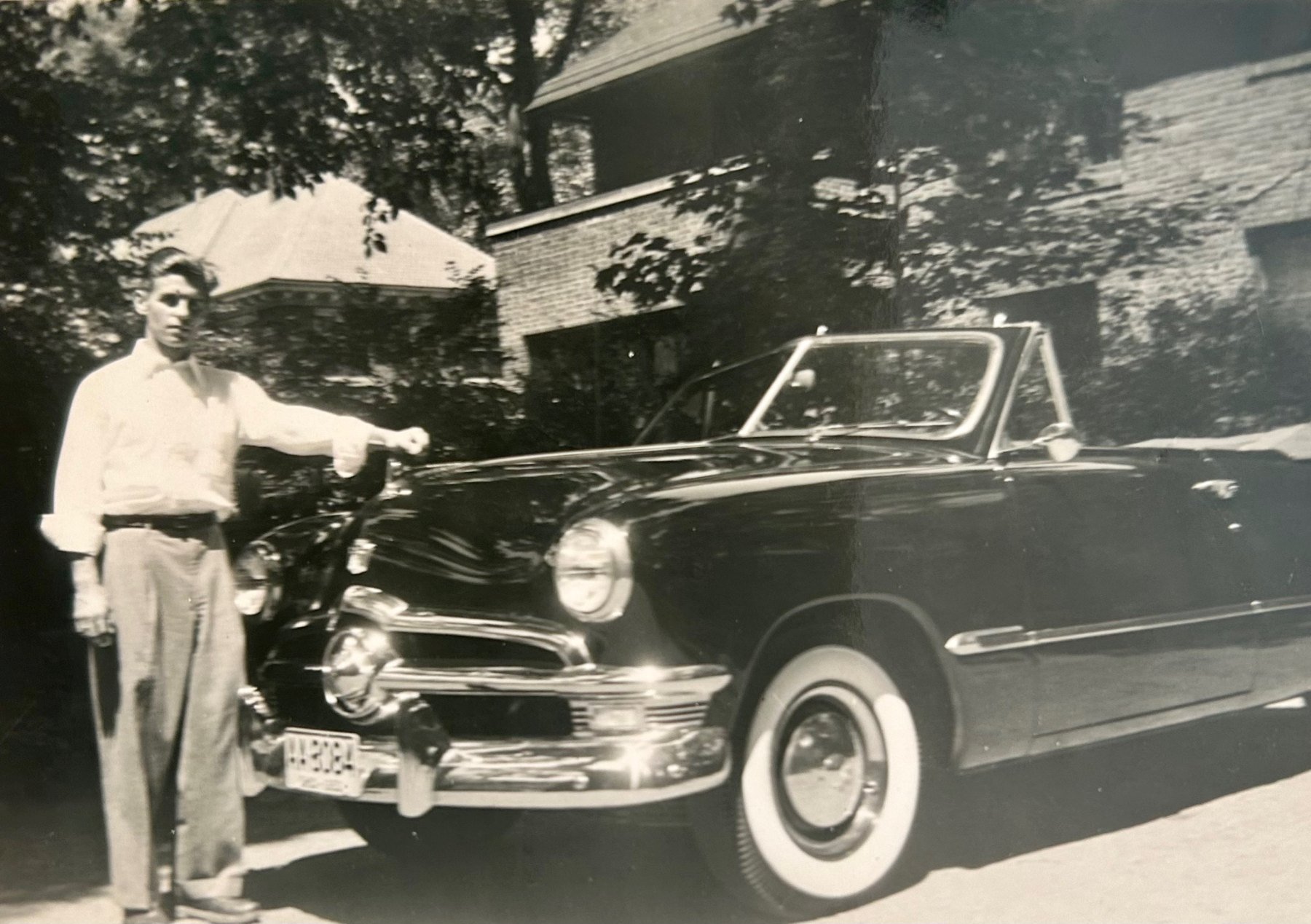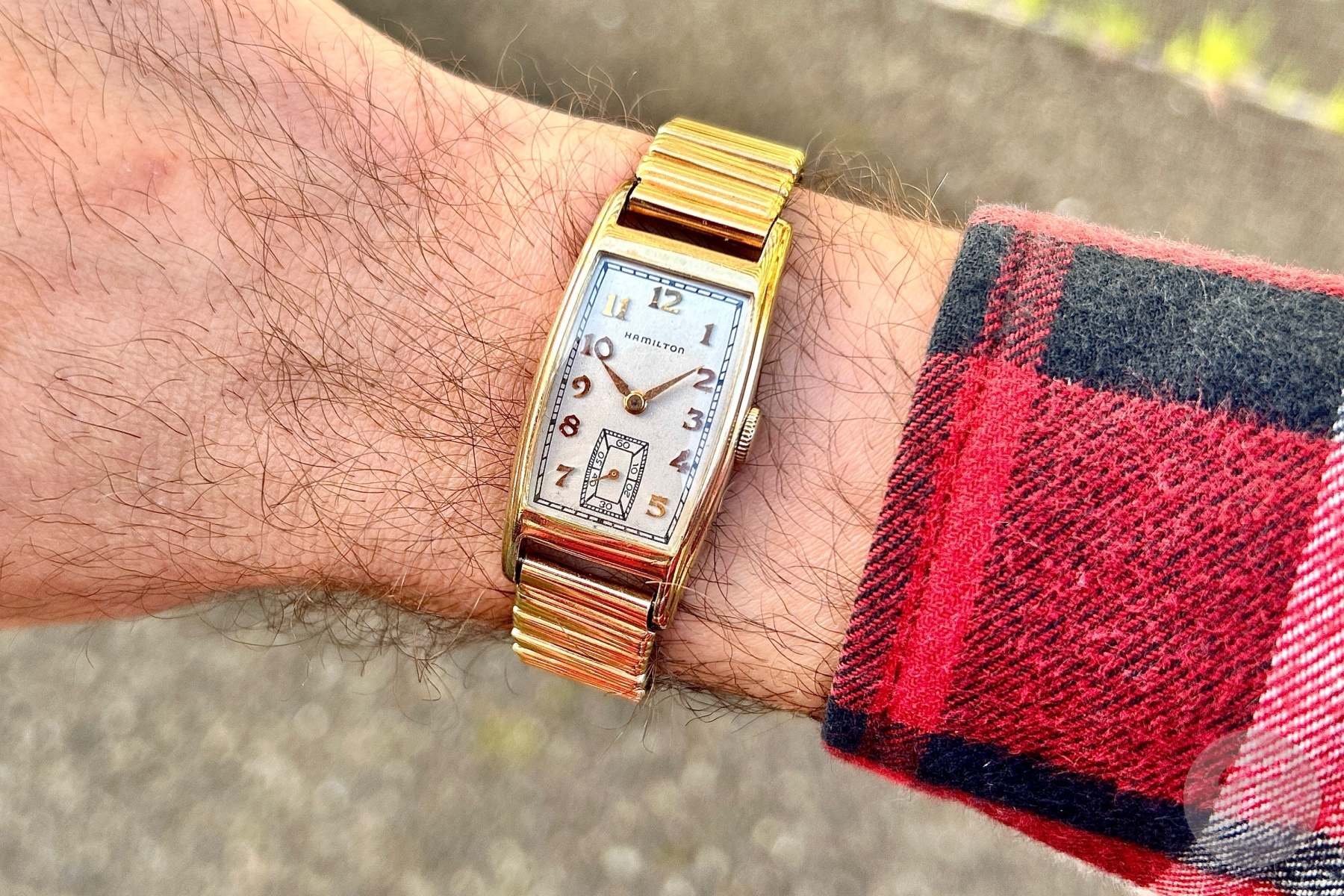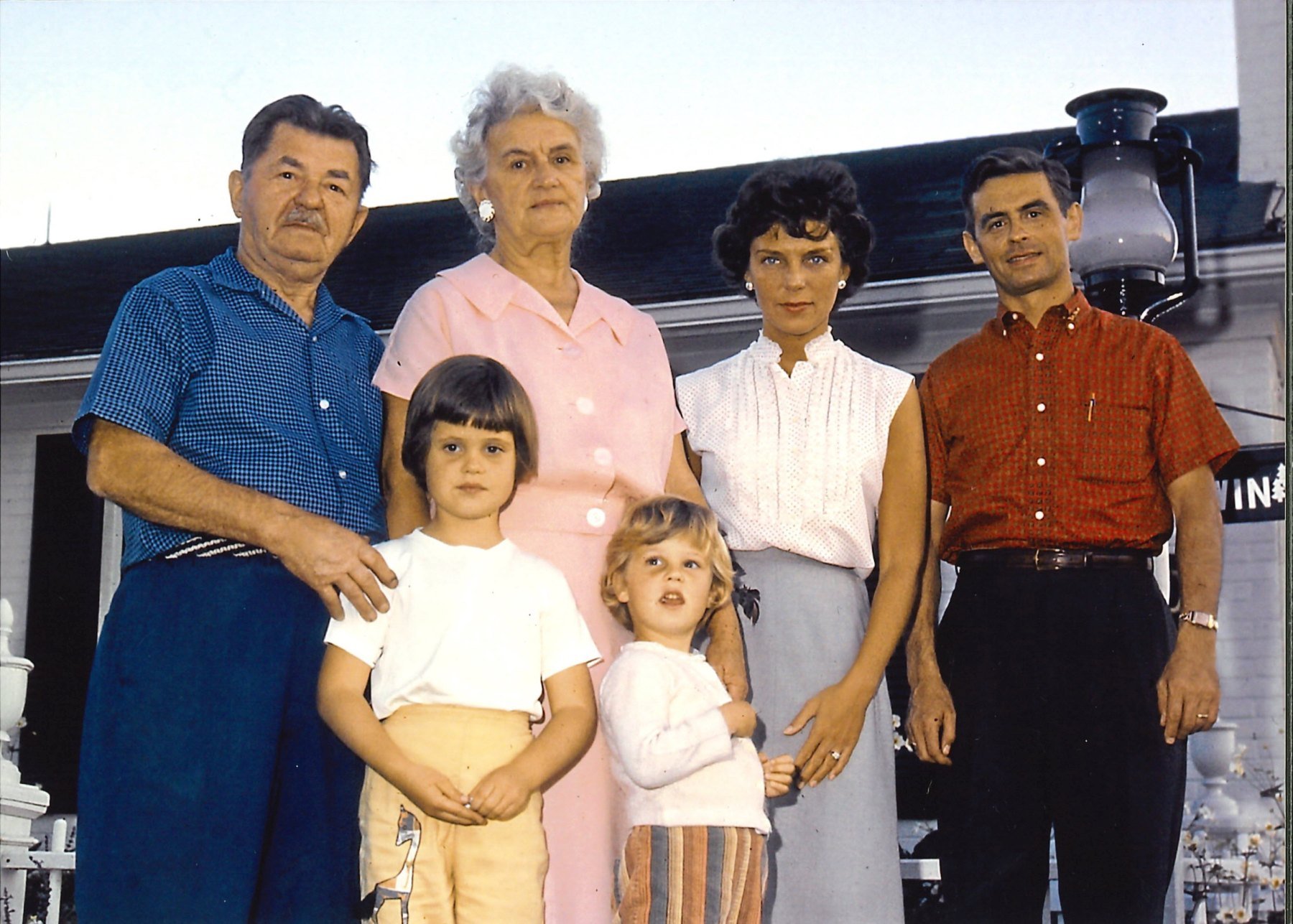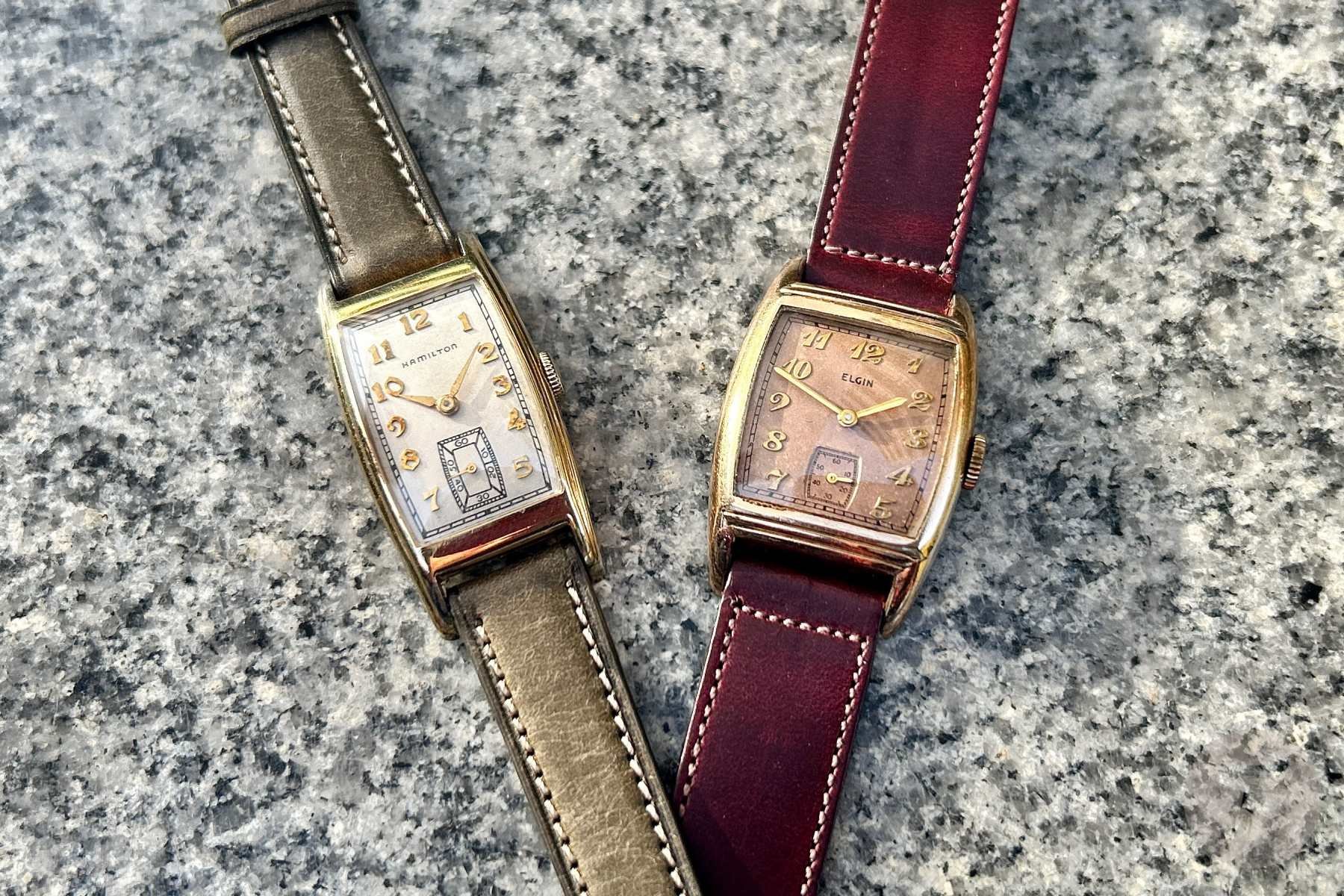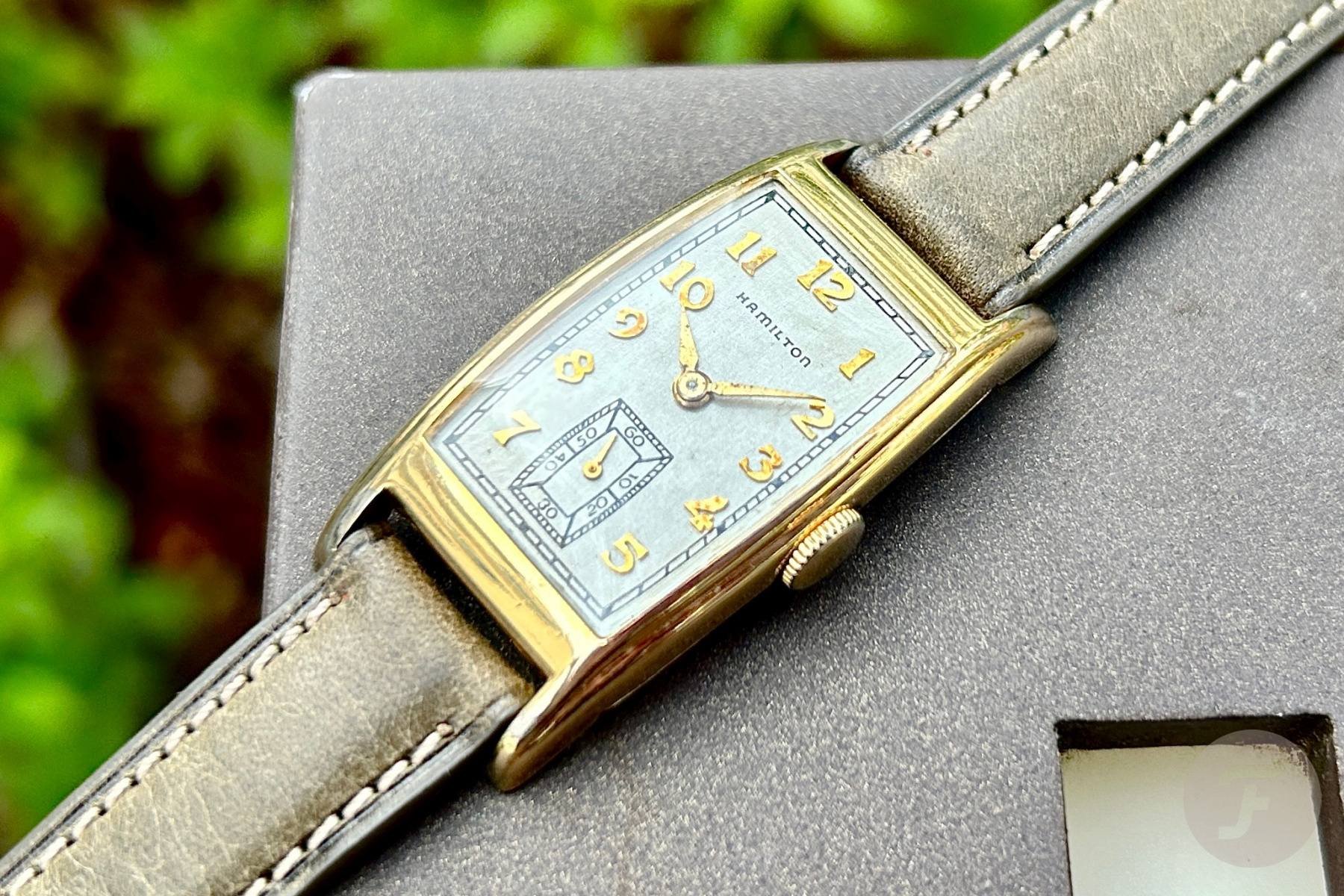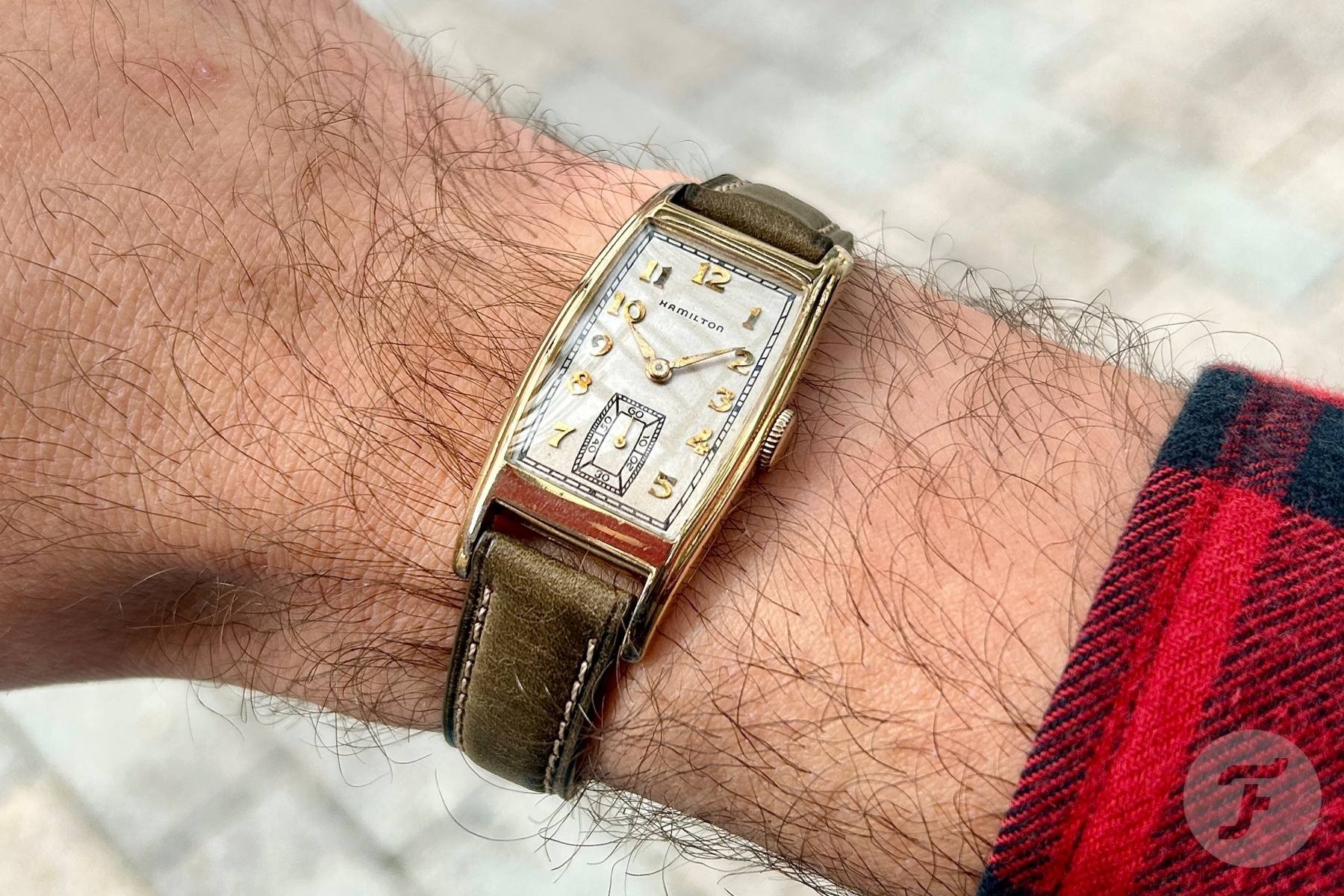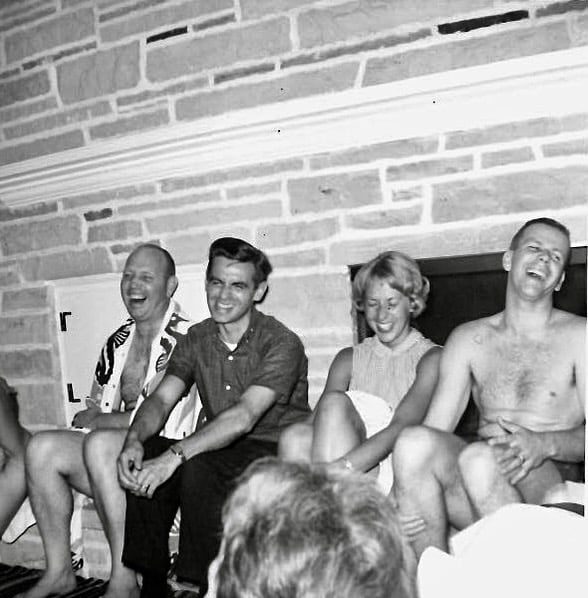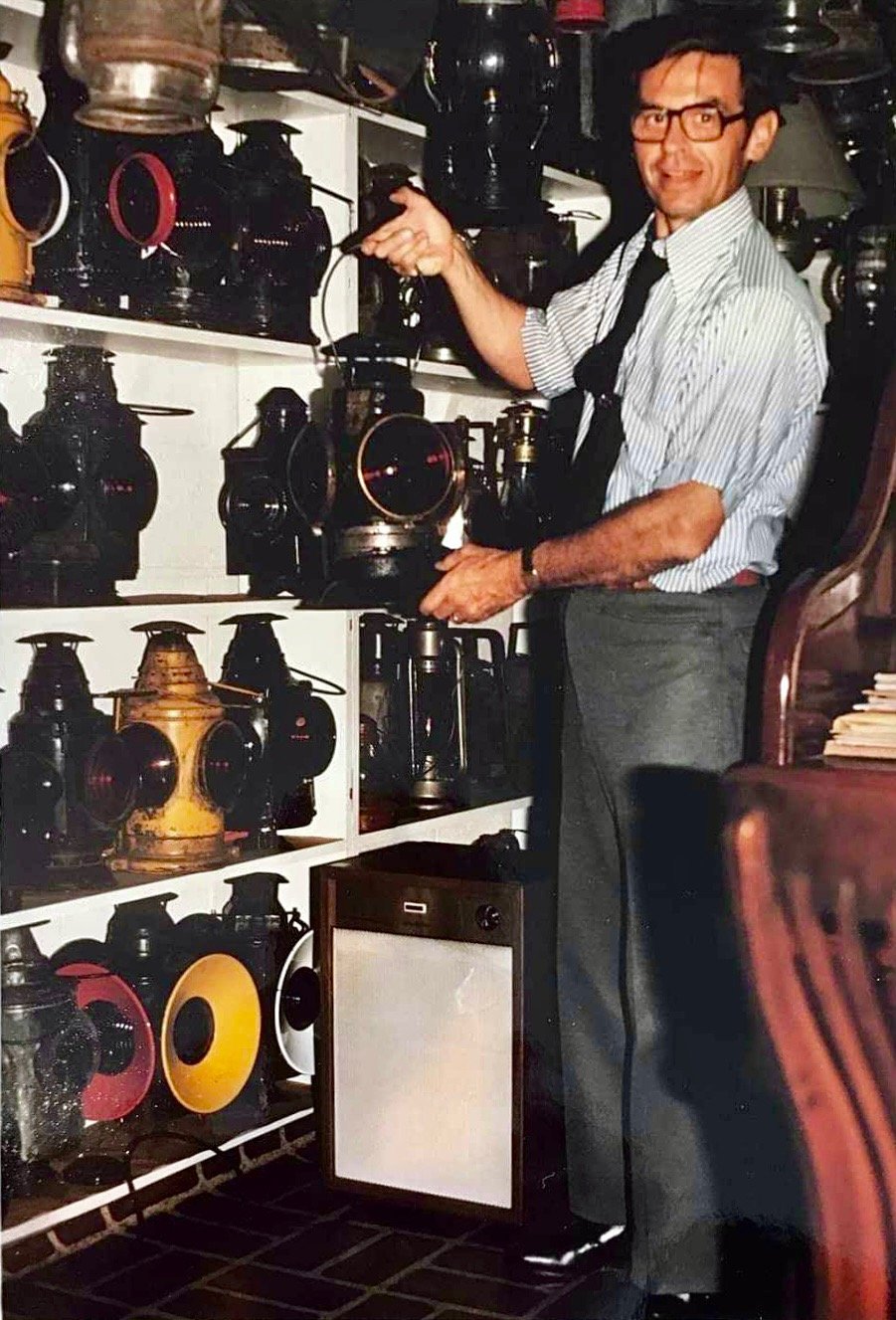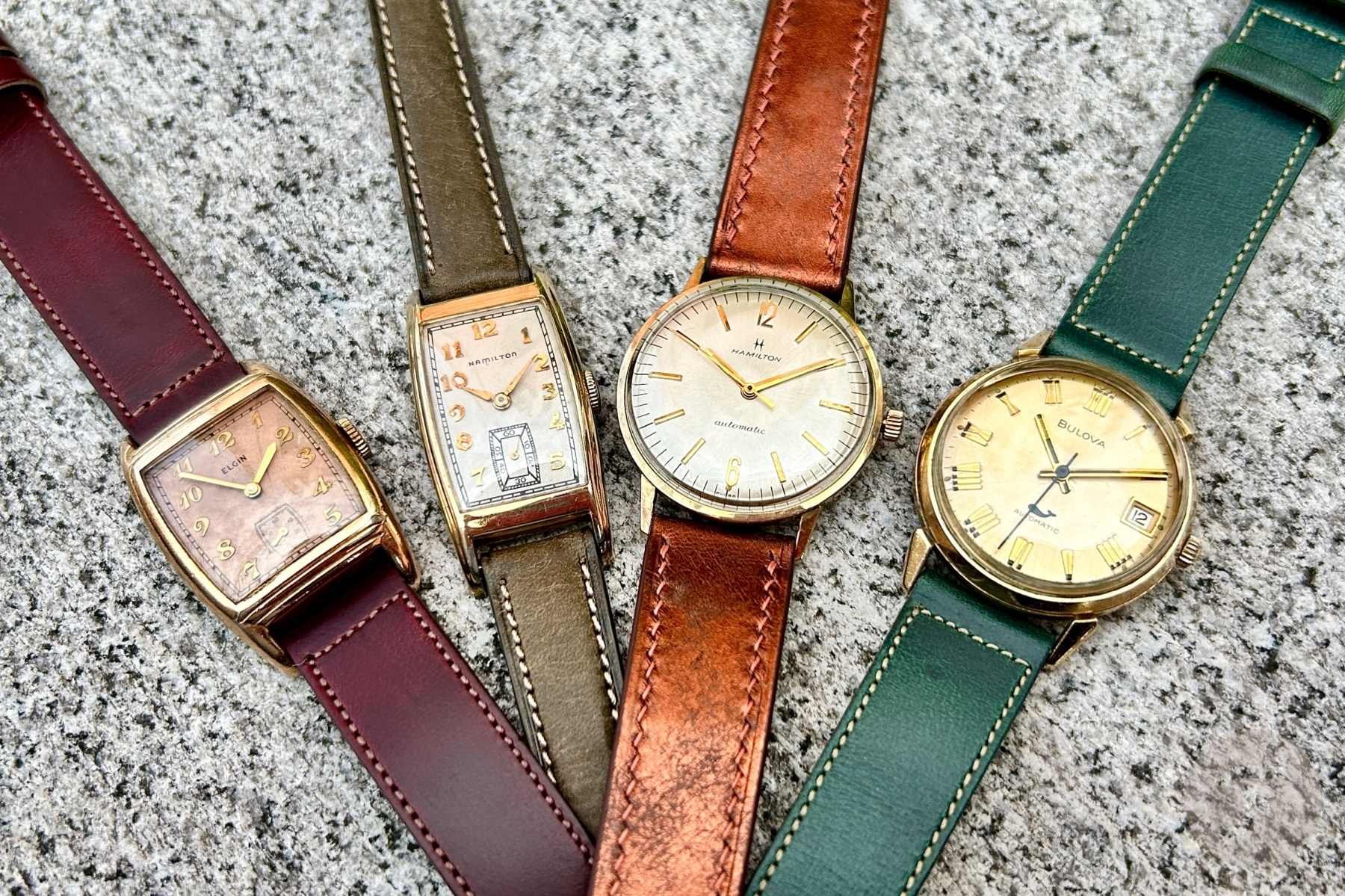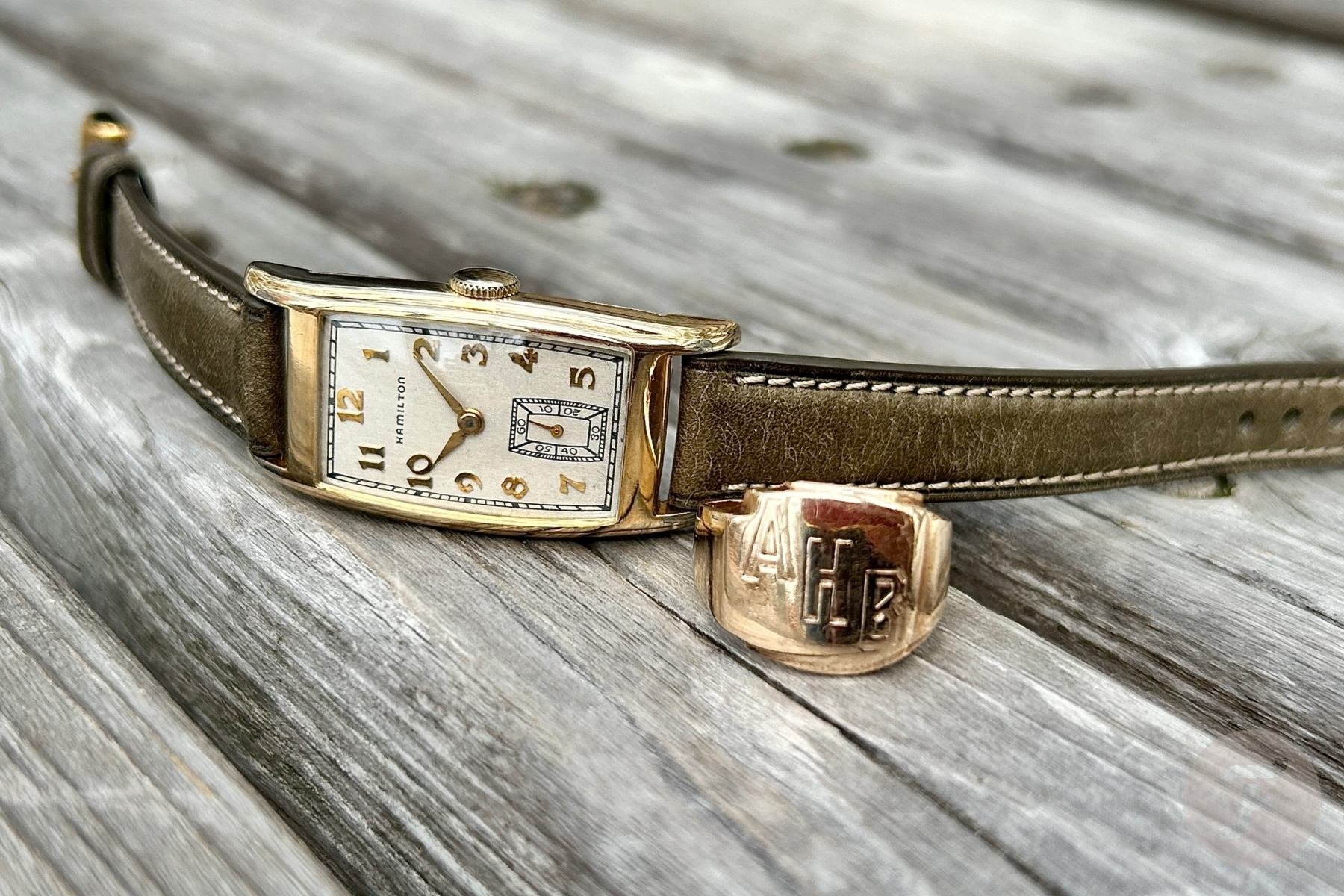Remembering My Grandfather Through His Watches: Part 1 — An Elgin 6703E And Hamilton Yorktowne From The Early ’40s
Since 2024 began, I have wanted nothing more than a chance to talk and laugh with my grandfather again. This year is the 18th since his passing, which was also half of my life ago now. Perhaps because of that, I feel as if I could finally comprehend and appreciate all of his insight and wisdom. As heartbreaking as it is that we will remain realms apart, I will forever be thankful for one of the gifts he gave me — a deep appreciation for mechanical watches. Although he passed away just as my passion was blooming, I have not a shred of doubt that he planted the seed within me. Now, having reunited with four of my grandfather’s watches, I will use them to learn more about him and honor his memory.
Today, I will share two of the wristwatches that belonged to Audré H. Balogh, my maternal grandfather. One is a Hamilton Yorktowne that my late grandmother passed on to me in 2008. The other is an Elgin 6703E that I only received last August after my aunt miraculously found it in a drawer. After traveling home to see my American family last summer, I decided to bring these watches back to Japan. I would no longer leave them in a drawer in my old bedroom in Maine, as had been the Yorktowne’s fate for 11 years. Instead, I would appreciate them, wear them, and use them as a springboard to discover more about my grandfather’s life. As wise folks always say, it’s better late than never.
The early life of Aud Balogh
Audré Howard “Aud” Balogh was born on March 30th, 1924, in Cleveland, Ohio, USA. Preceded by his then-five-year-old brother Herbert, Aud was the second son of Frank and Gizella Balogh (née Vargo). Growing up, Aud experienced a blend of American and Hungarian culture. His father had emigrated from Hungary in 1906 and come through Ellis Island before eventually settling in Cleveland. Similarly, Aud’s mother was a first-generation American born to Hungarian immigrants. They met at a Hungarian-owned store where Gizella worked when Frank came in one day to buy construction supplies.
Frank and Gizella often spoke to each other in Hungarian, and, along with English, Aud became proficient in his parents’ mother tongue as a boy. He also greatly admired his father, who, at 18 years old, escaped squalid working conditions in his homeland to forge a new life in the States. A carpenter, Frank Balogh had worked as an apprentice in Hungary. According to my mother’s account, he had even had to sleep in sawdust on the workshop floor. But after settling in Ohio, Frank mastered his trade and eventually took a job as an in-house carpenter for the Brotherhood of Locomotive Engineers (BLE). Undoubtedly, this had a massive influence on Aud, who would not only become a carpenter himself but also develop an unparalleled passion for the American railroad.
As my aunt recalls, when Aud was 11, he received a lantern from the driver of the milk or mail truck. This pivotal moment ignited his passion for lanterns, which were of vital importance to locomotive engineers. As he grew, Aud learned carpentry and drafting from his father and surely became increasingly interested in Frank’s employer’s industry. Aud then graduated from Cleveland Heights High School on June 11th, 1942, which brings us to the first watch in this story.
Elgin 6703E: My grandfather’s graduation watch
Founded in 1863 in Elgin, Illinois, the Elgin National Watch Company was a major player in the American watch industry for over a century. The company proudly advertised its American manufacturing and, quite understandably, spoke directly to the hearts of the nation’s patriots. Furthermore, according to print ads from the 1930s and ’40s, Elgin watches were incredibly popular graduation gifts.
“The traditional graduation gift—a watch. The traditional graduation watch—an ELGIN! And this year, more than ever, American graduates will choose ELGIN,” reads the 1940 advertisement above. A Google search of Elgin print ads from this period reveals a prevalent theme: Elgin watches were the prime choice of young Americans at the time. Though my grandfather was certainly proud of his Hungarian roots, he was equally proud to grow up in “the land of the free and the home of the brave.” It makes complete sense, then, that Aud would have loved an Elgin as his first adult watch.
Above, we see a 1941 example of Elgin’s patriotic advertising and, importantly, my grandfather’s would-be watch — No. 6703E — on the left. What’s so interesting to me is that this “America First” series made rose-tone Elgin watches more affordable than ever. According to Dollar Times, the watch’s original $24.75 price equates to $538.44 today, which was probably still a respectable sum for my grandfather’s middle-class family. The case of this model was base metal covered with rolled gold, which is not quite as thick as gold capping but “contains 100 times more gold than average gold plates.”
The evidence points to 1942
Unfortunately, my mother and aunt were unable to find any photographs of Aud wearing this watch in the 1940s. Out of curiosity, though, I ran the serial number on the Elgin 554 caliber inside through the Pocket Watch Database. Lo and behold, the estimated production year of 1942 lines up with Aud’s graduation from high school.
Furthermore, while the previous ad is from 1941, scans from the 1942 Elgin catalog via GeneJockey’s Elgin Watch Blog show that the 6703E was still in production. Interestingly, the price had also gone up by 75 cents, which was worth nearly $15 in today’s money. My aunt also has memories of my grandfather wearing this watch and, at some point, hearing the story of how he got it for graduation. Honestly, all this is enough evidence for me. I am just so thankful that my aunt found the watch when cleaning out my grandmother’s house after she passed.
When she gave me this Elgin, it was on a tough and cracked burgundy leather strap, pictured here. Clearly, this was the last strap that my grandfather paired with this watch. I loved the look of it with the rose-tone case and patinated salmon dial. However, since I plan to wear this watch, I opted for a rather fitting replacement.
I chose a burgundy strap made of Horween Chromexcel leather from Accurate Form. This leather was a conscious choice because the Horween tannery is in Chicago, not too far from the Elgin brand’s namesake city. Not only does this strap maintain the look that my grandfather had chosen, but it’s also exponentially more comfortable.
What I love about my grandfather’s Elgin 6703E
Admittedly, this watch is much smaller than the ones I usually wear. Its tonneau case measures a modest 30.5mm wide and just 39mm from lug to lug. Then again, this watch is from the early 1940s and was a perfectly acceptable men’s size at the time. Considering that, when paired with this 16mm non-tapering strap, it doesn’t feel too small for my 17cm (6.75″) wrist at all. Plus, at just 8.7mm thick, it offers all the under-the-cuff elegance I would ever desire. But what I find most striking is the hue of the rosé dial with the contrasting yellow-gold-tone numerals and hands. While it’s uncommon to see yellow and rose gold mixed this way today, I find the combination quite stunning. The font of the Breguet numerals is also marvelous, right down to the “plus sign” on the “4.”
I will be getting a thorough cleaning and service for this watch as soon as I can find a sympathetic watchmaker I trust here in Osaka. All things considered, though, the Elgin 554 caliber inside still looks rather nice for its age. And although I don’t want to push it too hard for now, it even runs reasonably well for having sat in a drawer for so long. I was pleasantly surprised to see the rubies set in chatons, which we now tend to associate with higher-end watchmaking. This was not a high-end watch, even within the Elgin range. With only 15 jewels (the jewel count was very important to customers back then), it sat below the 17-jewel Elgin DeLuxe and 21-jewel Lord Elgin lines. Nevertheless, with some TLC, I’m sure this Balogh family treasure will keep ticking for decades to come.
My grandfather’s life after high school
Equipped with his Elgin watch, Aud Balogh took a job straight out of high school with the General Electric company in Cleveland. He worked as a draftsman and, according to official military documents, “made detailed drawings of machine tools from sketches showing all dimensions, materials to be used, and other pertinent data.” However, with World War II still raging, Aud only worked for GE for roughly nine months before enlisting in the US Army. He entered active service on March 29th, 1943, one day before his 19th birthday.
According to US Army records, he would serve for the “duration of the War or other emergency, plus six months, subject to the discretion of the President or otherwise according to law.” With carpentry skills under his belt, Aud thankfully managed to stay away from the front lines while serving as a Tec 4 (Technician fourth grade). His official title was Carpenter General, and he served with the 55th Medium Port for six months in Saipan as a carpentry instructor. Upon returning to US soil for the remainder of his service, he continued that role. This included training groups for a year in Pennsylvania, helping others as they performed construction tasks around camp, building crates for overseas shipments, repairing company facilities, and constructing various small buildings.
Unfortunately, with no photographs, I can only speculate, but I like to think his Elgin watch faithfully accompanied my grandfather through this all. If only this watch could talk, I wonder what kind of stories it would tell…
After the war, life goes on
Having faithfully served his time in the US Army, Aud Balogh was honorably discharged on February 23rd, 1946. Following that, it seems he went back to work for a time before enrolling at the Dunwoody Institute (now Dunwoody College of Technology) in Minneapolis, Minnesota. There, Aud fittingly majored in Architectural Drafting & Estimating and graduated with the class of 1949. Then, after having already shown proficiency in his father’s craft, Aud decided to follow in Frank Balogh’s footsteps even further. In 1950, he secured a job with the very same company, the Brotherhood of Locomotive Engineers in Cleveland. He joined the BLE’s Building Association and received his first paycheck from the company on June 23rd of that year.
The importance of this for my grandfather cannot be overstated. He would spend the next 50 years in faithful service to the BLE, which eventually became the Brotherhood of Locomotive Engineers and Trainmen. This job would not only help him hone his carpentry skills even further but would also amplify his budding passion for the American railroad. Though he never became a train conductor, Aud would amass an incredible knowledge of trains, railroad infrastructure, lanterns, and, yes, railroad watches. He would collect tons of railroad memorabilia, including dozens of pocket watches from, among others, Waltham, Illinois Watch Company, and Hamilton.
Hamilton becomes my grandfather’s favorite watch brand
I completely understand why my grandfather gravitated to Hamilton. If you’ve read my article on the brand’s early years, you’ll understand the massive role that Hamilton played in railroad timekeeping. From the pivotal 1893 Grade No. 936 pocket watch to the Grade No. 992, the most popular American railroad watch ever, Hamilton produced watches of unmatched repute within the railroad industry. Unfortunately, my grandmother sold many of Aud’s Hamilton pocket watches after he passed. However, she did keep his Hamilton wristwatches and gave them to me. When I received them for Christmas back in 2008, she confirmed that Hamilton was indeed my grandfather’s favorite watch brand of all.
First comes love, then comes marriage…
My grandfather met Jacqueline “Jackie” Groth in the early 1950s. They lived on the same street and saw each other several times while riding the Rapid Transit into Cleveland for work. But it wasn’t until one day when Aud went to Jackie’s house to inquire about some lumber that her father was selling that they hit it off. As my mother recalls, Jackie’s mother said that Aud was “SO handsome” when he walked into their kitchen that day. Unfortunately, she doesn’t recall what my grandmother thought of him then, but a word like “dashing” seems appropriate to me. The two started dating, fell deeply in love, and became husband and wife on April 24th, 1954. Exactly two years and eight months later, my mother Holly was born, and her sister, my aunt Barbara, followed in April 1959.
Looking at photos from their days as newlyweds and young parents, it seems that Aud and Jackie were head over heels for each other. Importantly for this story, this is also when we start to see the Hamilton Yorktowne appear on my grandfather’s wrist. In the color photo above, he is wearing it on what looks like a gold bangle bracelet.
In this early ’60s family photo with his parents, we also see the Hamilton Yorktowne on his wrist. While this is far from a close-up, we can distinguish the watch thanks to its long, slender sides and wider surfaces at 12 and 6 o’clock.
The Hamilton Yorktowne
According to Vintage Hamilton Watch Restoration, the Yorktowne was only made for two years — 1940 and ’41. Above, we see it in the Hamilton catalogs from both of those years, but indeed, it was gone by 1942. This is interesting because it leads me to believe that my grandfather bought this watch secondhand. Unfortunately, I cannot confirm this, but it makes sense that he could’ve bought it after discovering Hamilton’s importance to the railroad. And when placed next to his Elgin 6703E, the Hamilton Yorktowne certainly seems like an “upgrade” of sorts.
Both watches feature Arabic numerals on their dials. The Hamilton Yorktowne’s, however, are applied and solid 18K gold, whereas the Elgin 6703E’s are simply stamped and gold plated. As you can see, the fonts are also different, with the Yorktowne’s numerals taking on a more Gothic style. Additionally, the Hamilton Yorktowne has a 10K-yellow-gold-filled case rather than a rolled-gold one. While similar in effect, according to The Vintage Compact Shop, a “gold-filled” plating is thicker, requiring two layers of gold instead of one. Notably, the Hamilton Yorktowne also cost significantly more when new, having come in at $45 in 1940 (about $986 today).
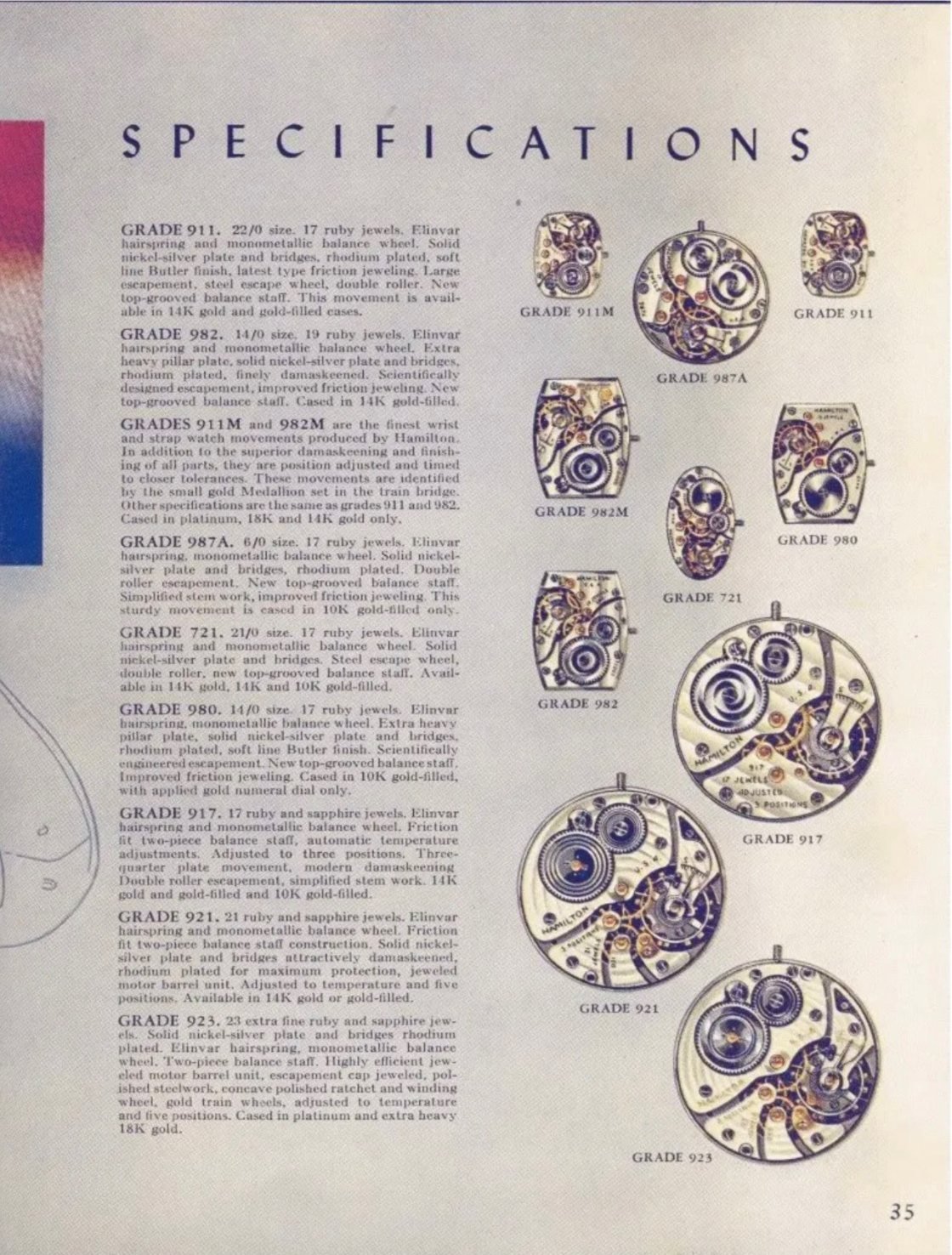
Hamilton calibers in the brand’s 1941 catalog — Image: Vintage Hamilton Watch Restoration (Hamilton Chronicles)
The Hamilton 980 caliber inside
Inside the Yorktowne beats Hamilton’s in-house Grade 980 movement. While the Elgin’s 15-jewel movement was round in a tonneau-shaped case, the shape of the Hamilton’s 17-jewel caliber suits the case better. Though it’s not easy to access without removing the dial (which I dare not do myself), we can see an illustration and description on the catalog page above. Notably, it used Hamilton’s fairly new Elinvar hairspring for more consistent elasticity and, therefore, greater resistance to temperature changes than traditional steel springs. In addition, it paired this with a monometallic balance, which was more antimagnetic than more common bimetallic counterparts. While the 980 wasn’t an elaborately decorated movement, it was as solid and reliable as one would expect of Hamilton calibers.
Appreciating my grandfather’s Hamilton Yorktowne
As shown earlier in the article, I received this watch on a 10K-gold-filled expandable bracelet. Though it is indeed comfortable, I also think the watch looks great on this olive-green leather strap. It tones the dressiness down a few notches but not so much as to detract from the elegant dial. For me, this is the sweet spot for casual wear. Admittedly, it’s rather hard to find good straps for this watch due to its 14mm lug spacing. One day, I will have a custom non-tapering nubuck strap made in a similar color.
The Yorktowne’s case measures just 21mm wide and 8.1mm thick but has a lovely 43mm lug-to-lug length. Again, it’s smaller than the watches I usually wear, but it suits the style of the early 1940s well. I am wearing it as I type this, and every time I glance down, it brings a very Aud Balogh-like grin to my face.
Seeing this watch on my grandfather’s wrist in pictures and now on mine in real life, I wish I could ask him about how and why he purchased it. What was it that drew him to the Hamilton Yorktowne? Was it the fact that it a shared similar style with his Elgin but had a slightly nicer execution? Was it the Hamilton brand’s connection to the railroad? Or was it both of these factors…or neither of them? My goodness, how I long to spend time with him again, bonding over the things I never appreciated when I was a child.
To be continued…
This may be the first, but it will not be the last time that I explore my grandfather’s history through his watches. I have two more of his wristwatches here with me in Japan, and I will do my best to learn about them and how they fit into his life. I found out so much about him while preparing this article, and it is the best way I know how to pay tribute to this passionate, caring man.
As far as every photo and memory that I have suggests, my grandfather never wore a quartz watch in his lifetime. He valued tradition and, as a carpenter, surely appreciated the manual aspect of mechanical watchmaking. Now, at nearly 36 years old, I truly appreciate the watches and passionate spirit that I inherited from him. Furthermore, I am prouder than ever to be named Brandon Balogh Baines.
Audré Howard Balogh would have been 100 years old today, March 30th, 2024. Happy birthday, Grampy. I hope I’m making you proud.

